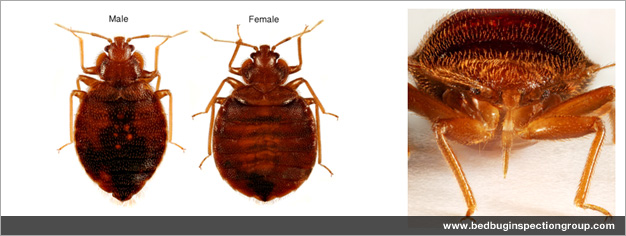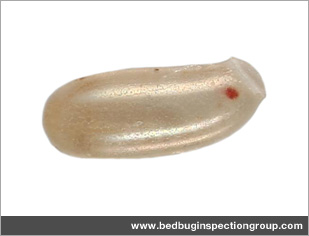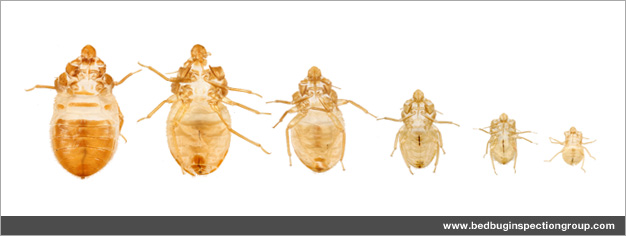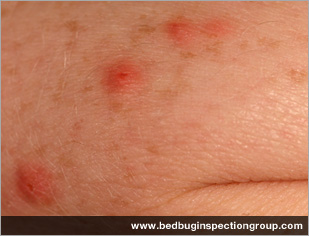Bed Bug Facts
The more you know about bed bugs, the more aware you will be of the need for regular bed bug inspections. Select a topic below.
What do bed bugs look like?
What do bed bug bites look like?
Besides bed bugs what else could be biting me?
Adults
Adult bed bugs are flat brown insects similar in size and shape to an apple seed (approx. 3/16 inch long). Male and female bed bugs are similar in size but differ in the shape of the abdomen. The male’s abdomen is more pointed (like a lemon), while the female’s abdomen is more rounded (like an orange). When bed bugs are hungry, their abdomens are virtually flat, but after feeding they become distended and swollen with blood.

Like all true bugs, bed bug mouthparts are modified into a drinking straw-like structure called a proboscis, which is used to pierce the skin and draw up blood. The proboscis is usually tucked under the body when the bug is not feeding, so it may only be visible when viewed from underneath.
Unlike most other insects, bedbugs do not have wings or elytra (wing cases), which means that their segmented body is clearly visible when viewed from above. This feature can help to distinguish bed bugs from beetles of a similar size and color.
Nymphs
 Baby bed bugs are called nymphs. Bed bug nymphs range in size from 3/64 to 3/16 inch. They broadly resemble the adult, except that the cuticle is thinner, and therefore paler in color. As a consequence, the gut is clearly visible as a dark region showing through the abdomen.
Baby bed bugs are called nymphs. Bed bug nymphs range in size from 3/64 to 3/16 inch. They broadly resemble the adult, except that the cuticle is thinner, and therefore paler in color. As a consequence, the gut is clearly visible as a dark region showing through the abdomen.
Eggs
Bed bug eggs are smooth, oval, pear-colored and about 3/64 inch in length. Under magnification it is possible to see a cap at one end, from which the nymph will emerge. It is also possible to see two red spots (one on each side), which are the eyes of the developing nymph inside the egg.
 Eggs are laid in clusters in the harborage, where the bugs spend most of their time between feeds. They are generally glued onto hard surfaces in inaccessible cracks, making them hard to find. This also makes them very difficult to dislodge by vacuuming and similarly difficult to treat with chemical insecticides.
Eggs are laid in clusters in the harborage, where the bugs spend most of their time between feeds. They are generally glued onto hard surfaces in inaccessible cracks, making them hard to find. This also makes them very difficult to dislodge by vacuuming and similarly difficult to treat with chemical insecticides.
Exuvia
Bed bug nymphs shed their skins at approximately weekly intervals as they develop. These cast skins (exuvia) are extremely light and fragile. They often fall to the ground beneath the bed and can be an important indicator of an infestation, since the bugs themselves are notoriously good at remaining hidden.

Fecal spotting
 As bed bugs digest their blood meal they excrete the unwanted byproducts as aqueous fecal droplets. These inky spots range in color from tan to black, with darker spots being more common. On shiny surfaces such as varnished wood, the spots dry as a raised lump, but on absorbent surfaces such as bed sheets, the spots are wicked into the fibers, resembling ink from a pen.
As bed bugs digest their blood meal they excrete the unwanted byproducts as aqueous fecal droplets. These inky spots range in color from tan to black, with darker spots being more common. On shiny surfaces such as varnished wood, the spots dry as a raised lump, but on absorbent surfaces such as bed sheets, the spots are wicked into the fibers, resembling ink from a pen.
Still not sure if you have bed bugs? Contact us »
Insect bites can be very difficult to diagnose. This is because the skin reaction people experience has more to do with the immune system of the bitten person than the insect responsible for the bite. That said, there are certain key features that are typical of bed bug bites.
Physical appearance
 For most people, bites occur as red, raised lumps, which are extremely itchy, particularly when the skin temperature is higher, such as in bed or in the shower. In a minority of cases the bites can form yellowish blisters and/or weep clear fluid. It is also possible for the bites to result in more severe swelling of the surrounding tissue. This can be indicative of a secondary infection and may require medical attention.
For most people, bites occur as red, raised lumps, which are extremely itchy, particularly when the skin temperature is higher, such as in bed or in the shower. In a minority of cases the bites can form yellowish blisters and/or weep clear fluid. It is also possible for the bites to result in more severe swelling of the surrounding tissue. This can be indicative of a secondary infection and may require medical attention.
Location
Bed bugs tend not to squeeze under clothing or bed covers. Instead they look for areas of exposed skin, such as the neck, shoulders and arms. Sometimes they will climb onto the skin, but more often they prefer to feed from the surrounding fabric with only their mouthparts in contact with the skin. Occasionally they have to relocate a couple of times in order to find a suitable capillary. As a result of this they have a tendency to produce a row of 2-3 bites, usually not more than an inch apart, along the edge of the exposed skin. This pattern is sometimes referred to as “breakfast, lunch and dinner” although in reality it is only the result of a single meal.
Delayed reaction
Unlike most insect bites, the skin reaction to a bed bug bite can be delayed by up to two weeks. Consequently, if you are bitten while traveling it can be difficult to determine exactly where you encountered the bed bugs. With multiple exposures to bed bugs, the delay is reduced, and in some cases people stop reacting entirely.
How quickly can an infestation develop?
Because of the delayed reaction to bed bug bites and their ability to hide deep within the structure of the bed, infestations typically go undetected for the first few weeks. When the first bites appear they are often dismissed as mosquito or flea bites, which allows the infestation time to become established.
Adult female bed bugs can produce 15-25 eggs per week and may live up to a year. In warm conditions (ca. 75°F) eggs hatch in about 1 week and, with regular access to a host, can reach maturity within 6 weeks. At this point up to 25 new adults may be reaching maturity every week, and will begin laying eggs of their own.
In the early stages, infestations tend to be in close proximity to the feeding site (usually the bed), but as the infestation develops, it typically spreads out into more peripheral locations around the room, and then to neighbouring rooms, which is why early detection is so important.
Still not sure if you have bed bugs? Contact us today »
Just because you have bites, doesn’t mean you have bed bugs. There are a number of other biting insects and skin conditions that can cause very similar reactions.
Head lice - Bites only occur on the head, particularly around the back of the neck and behind the ears.
Body lice / crab lice - Bites only occur in areas of pubic hair.
Mosquitoes / midges - Bites tend to be seasonal. Mosquitoes are usually seen roosting on the walls or ceiling.
Fleas – Where cats or dogs are resident, fleas should always be the first consideration. Even when no cat or dog is present fleas can be picked up from walking in the garden. This tends to occur when an animal has died in the vicinity and the fleas have dispersed to find a new host. Flea bites tend to occur on the feet and ankles, although they can bite anywhere.
Bird or rodent mites – These tend to occur when a bird or rodent dies in the house and the mites disperse. They are very small and young ones are approaching microscopic. They often produce a crawling sensation over the skin, although they can be very difficult to find. Bites can occur anywhere on the body.
Chiggers – These are microscopic mites, usually picked up from long grass. They either bite or burrow into the skin to reproduce, causing intense itching. Bites usually occur on the arms and legs.
Scabies – Like chiggers, these are microscopic mites, but they are contracted from direct skin contact with an infected person. Bites are generally worst between the fingers, but can spread to other parts of the body.
Swallow bugs/Martin bugs/Bat bugs – There are several species of bug, related to the bed bug, which are primarily parasites of bats and birds. These can occur in homes where bats or birds are resident. In most cases they only cause a problem if their primary host leaves. In which case the bugs may disperse into the living areas of the house to find an alternative host.
Skin complaints – A range of skin complaints can produce bite-like marks, which can be mistaken for insect bites. Ingrown hairs, certain types of eczema and allergic reactions are frequently misdiagnosed as insect bites.



